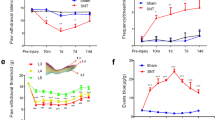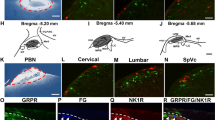Abstract
The central terminals of small diameter primary sensory neurones associated with the transmission of noxious cutaneous stimuli are located predominantly in the superficial dorsal horn of the spinal cord1–3. Some of these neurones synthesize substance P (ref. 4) and transport this peptide to their central and peripheral terminals5–7. Substance P is released from the dorsal horn in vitro following potassium depolarization8,9; from spinal cord after electrical stimulation of dorsal roots10 and from dissociated sensory neurones grown in culture11. The iontophoretic application of substance P produces a long-lasting excitation of dorsal horn neurones that are also excited by noxious cutaneous stimuli12–14. One population of opiate receptors in the dorsal horn seems to be located on primary afferent terminals15–16; the release of substance P from primary sensory neurones is inhibited by opiates in vitro8,11. At present, however, there is no direct evidence that substance P is released from sensory neurones, in vivo, following activation of nociceptive afferents. We report here that substance P-like immunoreactivity is released from the mammalian spinal cord, in vivo, following chemical stimulation of sensory neurones with capsaicin and by the activation of high threshold peripheral afferents. Furthermore, release of substance P evoked by high intensity stimuli is completely inhibited by intrathecal morphine.
This is a preview of subscription content, access via your institution
Access options
Subscribe to this journal
Receive 51 print issues and online access
$199.00 per year
only $3.90 per issue
Buy this article
- Purchase on Springer Link
- Instant access to full article PDF
Prices may be subject to local taxes which are calculated during checkout
Similar content being viewed by others
References
Rethelyi, M. J. comp. Neurol. 172, 511–528 (1977).
Light, A. R. & Perl, E. R. J. comp. Neurol. 186, 117–132 (1979).
Ralston, H. J. & Ralston, D. D. J. comp. Neurol. 184, 643–684 (1979).
Harmar, A., Schofield, J. & Keen, P. Nature 284, 267–269 (1980).
Takahashi, T. & Otsuka, M. Brain Res. 87, 1–11 (1975).
Hökfelt, T., Kellerth, J.-O., Nilsson, G. & Pernow, B. Science 190, 889–890 (1975).
Hökfelt, T. et al. in Substance P (eds Von Euler, U. & Pernow, B.) 117–145(Raven, New York, 1977).
Jessell, T. M. & Iversen, L. L. Nature 168, 549–551 (1977).
Gamse, R., Molnar, A. & Lembeck, F. Life Sci. 25, 629–636 (1979).
Otsuka, M. & Konishi, S. Nature 164, 83–84 (1976).
Mudge, A. W., Leeman, S. E. & Fischbach, G. D. Proc. natn. Acad. Sci. U.S.A. 76, 526–530 (1979).
Henry, J. L. Brain Res. 114, 439–451 (1976).
Randic, M. & Miletic, V. Brain Res. 128, 164–169 (1977).
Zieglgansberger, W. & Tulloch, I. Brain Res. 166, 273–282 (1979).
Lamotte, C., Pert, C. B. & Snyder, S. H. Brain Res. 112, 407–412 (1976).
Jessell, T. M., Tsunoo, A., Kanazawa, I. & Otsuka, M. Brain Res. 168, 247–259 (1979).
Yaksh, T. L. & Rudy, T. A. Physiol. Behav. 17, 1031–1036 (1976).
Yaksh, T. L. & Rudy, T. A. J. Pharmac. exp. Ther. 202, 411–428 (1977).
Jancso, N. Proc. 3rd Int. Pharmac. Meeting 33–35 (Pergamon, London, 1966).
Szolcsanyi, J. J. Physiol., Paris 73, 251–259 (1977).
Jancso, G., Kiraly, E. & Jancso-Gabor, A. Nature 270, 741–743 (1977).
Gamse, R., Holzer, P. & Lembeck, F. Br. J. Pharmac. 68, 207–213 (1980).
Jessell, T. M., Iversen, L. L. & Cuello, A. C. Brain Res. 152, 183–188 (1978).
Yaksh, T. L., Farb, D. H., Leeman, S. E. & Jessell, T. M. Science 206, 481–483 (1979).
Theriault, E., Otsuka, M. & Jessell, T. M. Brain Res. 170, 209–213 (1979).
Nagy, J. et al. Brain Res. 186, 435–444 (1980).
Hökfelt, T., Ljungdahl, A., Terenius, L., Elde, R. & Nilsson, G. Proc. natn. Acad. Sci. U.S.A., 74, 3081–3085 (1977).
Glazer, E. J. & Basbaum, A. I. Soc. Neurosci. Abstr. 5, 723 (1979).
Hökfelt, T., Terenius, L., Kuypers, H. G. & Dann, O. Neurosci. Letts 14, 55–60 (1979).
Hunt, S. P., Emson, P. C. & Kelly, J. S. Neurosci. Letts. Suppl. 3, 200 (1979).
Yaksh, T. L. & Wilson, P. R. J. Pharmac. exp. Ther. 208, 446–453 (1979).
Reddy, S. V. & Yaksh, T. L. Brain Res. 189, 391–401 (1980).
Mroz, E. & Leeman, S. E. in Methods of Hormone Radioimmunoassay 121–137 (Academic, New York, 1979).
Author information
Authors and Affiliations
Rights and permissions
About this article
Cite this article
Yaksh, T., Jessell, T., Gamse, R. et al. Intrathecal morphine inhibits substance P release from mammalian spinal cord in vivo. Nature 286, 155–157 (1980). https://doi.org/10.1038/286155a0
Received:
Accepted:
Issue Date:
DOI: https://doi.org/10.1038/286155a0
This article is cited by
-
Genetic and pharmacological antagonism of NK1 receptor prevents opiate abuse potential
Molecular Psychiatry (2018)
-
Post-operative Weaning of Opioids After Ambulatory Surgery: the Importance of Physician Stewardship
Current Pain and Headache Reports (2018)
-
Morphine hyperalgesia gated through microglia-mediated disruption of neuronal Cl− homeostasis
Nature Neuroscience (2013)
-
Differential Adeno-Associated Virus Mediated Gene Transfer to Sensory Neurons following Intrathecal Delivery by Direct Lumbar Puncture
Molecular Pain (2010)
Comments
By submitting a comment you agree to abide by our Terms and Community Guidelines. If you find something abusive or that does not comply with our terms or guidelines please flag it as inappropriate.



